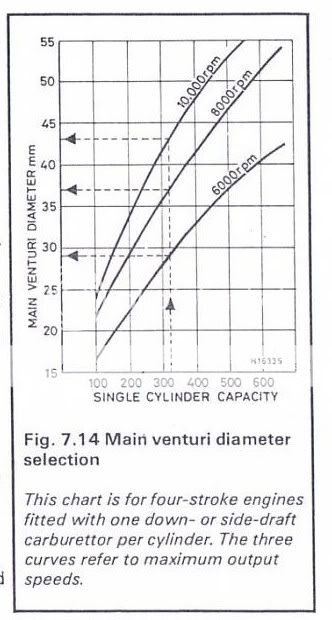Independent runner systems for the I6 are in there infancy at the moment. The use of six RS 40/38/36 or 34's will allow a well set-up log, 2v, SP or 240/300 engine yield very good power.
Points to note:
Sizing:
The RS 38 carbs are rated at about 165 cfm at 12" H20 per carb, and the ideal rev range is defined by the ancient Weber chart.
In most cases, the RS flatside carbs are set up for about 25 to 35 hp per carb. If six go on an I6 vehcile, it must be cammed to suit 150 to 210 flywheel horsepower. The RS carbs revolve around 9000 rpm, but an I6 only sees about 5500 rpm tops. The actual rev range at which the carb flows its ideal power needs to read off the chart above. If you have a 4900 cc six, yopu have to esitmate what rev range a 800 odd cc cylinder will rev to with an RS40. It will be about 5000 rpm. With a 200, an RS 38 carb will be serving 544 cc per cylinder, and the power will come in at 6000 rpm. A stock 252 degree factory Ford cam won't even run with an RS 38 carb. If you run a set of RS 34's, it will run fine to 5000 rpm
Later after market Harley Davidsons run optional aftermarkets kits
Mikuni HSR42: 213 CFM, 72-75 hp
Mikuni HSR45: 237 CFM, 100 HP OR SO
Mikuni HSR48: 270 CFM, UP TO 156 HP ON EVO 113 .
These supply way too much fuel with the jets, so its better to stick with cheap and availble Jap bike carbs.
The
throttles are linked to a common cable. You must ensure that the mechanical advantage supplied by the accelerator pedal is long enough to reduce the load of six carbs. A binding cable will create terriable problems. It's better to have a long, light accelertor pedal than a short sharp one. The carbs will provide extreamely fine fuel adjustment. If you've ever been fortunate to sit behind the pedals of a V12 Lamborghini, you notice how very long the throttle travel is.
If part of the key is selecting the right Mikuni for the rev range, then the
needles and jets are the next step. They are available from American Mikuni, and the key method of running them is to ensure the carb system runs a bleadback supply line which ensures the carbs never see more than 0.5 pounds per sqaure inch of pressure.
You do this by supplying a looped circuit line such as a port EFI fuel rail system on a 4.9 EFI Ford or 4.0 EFI Jeep. The blead back valve is just an old Holley jet sized to meet the planned horse power delivery. This system ensures the fuel bowls and jets function the way the Japanese engineers intended. The fuel most be diverted back to the tank or to a return line. If you think you can tune one without one, then you'll have to ditch all the information Mikuni have emased over the last 30 years.
The actual jet discharge is via anular area. Mikuni rate the flow discharge by the rise of the slides. The amount of manifold absolute pressure defines the cubic centimeters per second flow. In this respect, it mechanically does what the American Auto industry has spent billions on training expeosvie fuel injection systems over the last 50 years
Jack ran the RS 38 carbs on his 200, but ditched them due to the difficulty in setting up the needle profiles and finding a way to reduce the stock 5 psi to the same pressure as a motorcylces header tank.
The aftermarket, like Tucker Rocky ATV's,
http://www.mineolamoto.com/catalog_...4&ManufacturerCode=458&PartHeaderNumber=61808
can supply jets, needles. You must know:
Mikuni Kit Number from the original application
(This defines the General carb Spacing, the Throttle Shaft Number, the spacings of the carb bracket, the Spigot diameter etc.
Common types are RS36-D3-K
**RS36-D9-K from GSX-600 88, GSX-R 750 ,GSX-R1100,GS 1000-1150, KZ 1000-1100
RS38-D19-K
**RS38-D29-K from GSX-R 750, GSX-R1100,GS 1000-1150KZ 1000-1100
RS40-D1-K
**RS40-D7-K from GSX-R , GSKZ RACE)
There are five key tuning pieces.
Main Jet
(N100.604)
*Needle Jet
(J

(Clip Pos.)
Needle Jet
#568
(784-13002)
Pilot Jet
(VM28/486)
Pilot Screw
(Turns)
Check the details on
http://www.mikuni.com/fs-carburetor.html
The rest is just dyno time, and ensuring the full load air fuel mixtures are within spec. Part throttle and general tune must follow normal bike tuning. What happens with idle and progression is an unkown. Baja racers and guys like Esslinger have used these carbs on off road Pinto engined racers for years, so the information is out there.


